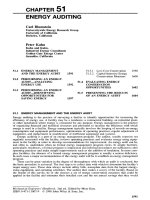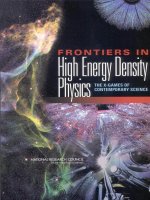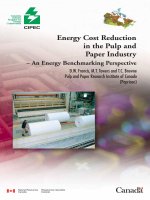Green Energy Course Syllabus docx
Bạn đang xem bản rút gọn của tài liệu. Xem và tải ngay bản đầy đủ của tài liệu tại đây (13.76 MB, 156 trang )
Green Energy Course Syllabus
CHAPTER 1: Introduction to Green Energy (1 lecture)
CHAPTER 2: Electric Power Industry - Distributed Generation Technologies (1 lecture)
CHAPTER 3: Wind Power Systems (2 lectures)
CHAPTER 4: Solar Resource- Photovoltaic Materials (1 lecture)
CHAPTER 5: Photovoltaic Systems (3 lectures)
CHAPTER 6: Energy Storage - Electric Vehicles (1 lecture)
CHAPTER 7: Other Renewable Energy Resources (0.3 lecture)
CHAPTER 8: Smart Grid (0.7 lecture)
TUTORIALS: DC-DC Converters; MPPT; Roof Top Solar Home; HOMER Sofware; PV+ Wind
Power Problems; Papers on RE
LABS: on RE topics
Renewable Energy and Energy Storage for
A Sustainable Development: What Alternatives?
A look on energy, renewable energies, energy storage and
synthetic fuels, hybrid architecture, fuel cells, hydrogen as
a vector of energy of the future.
2/18/2012 2
CHAPTER 1: Introduction to
Green Energy Technology
Biên sọan: Nguyễn Hữu Phúc
Khoa Điện- Điện Tử- Đại Học Bách Khoa TPHCM
The Earth resources are quite limited in quantity
Many challenges to mankind in 21
st
century: development,
health, water, food, demography, education, energy
Energy…
for a sustainable development
2/18/2012 3
Energy
is an abstract concept for different concrete manifestations
• In physics, energy(Ancient Greek: ἐνέργεια energeia "activity, operation"
[1]
) is a quantity that is
often understood as the ability a physical system has to produce changes on another physical
system.
[2][3]
The changes are produced when the energy is transferred from a system to another. A
system can transfer energy by means of three ways, namely: physical or thermodynamical work,
heat transfer, or mass transfer.
• Energy is a scalar physical quantity. In the International System of Units (SI), energy is measured in
joules, but in many fields other units, such as kilowatt-hours and kilocalories, are customary.
• Energy is by nature of conservation: Energy may not be created nor destroyed.
• Any form of energy can be transformed into another form. When energy is in a form other than
thermal energy, it may be transformed with good or even perfect efficiency, to any other type of
energy.
• With thermal energy, however, there are often limits to the efficiency of the conversion to other
forms of energy, as described by the second law of thermodynamics. Depending on circumstances,
some fraction of thermal energy exists in a form unavailable for further transformation; the
remainder may be used to produce any other type of energy, such as electricity.
-cooking, heating
- lighting
- mechanical work: machines
-Industrial processing
- information processing
-transports
Primary sources of energy
Fire from burning wood or oil
Animal force (horses, dogs, buffalos,…)
Water of rivers and tides (mills, …)
Wind (pumps, mills,…)
And other forms of renewable energies
2/18/2012 5
Energy sources of 21st century
• Fossil fuels: coal, oil, natural gas
• Nuclear Energy
• Electricity: secondary form of energy as of modern energy type of high
quality, synonym of development.
• During 20 th century, there are great concerns for our green planet:
- natural resources are quite limited, especially in terms of energy
- mankind is destroying the earth environment in the process of his
development
• What is the future: towards a development with renewable resources?
• And which new energy vectors will be adapted?
2/18/2012 6
=> Primary Energy and Energy Storage Vectors
Electrification of the world
Vision
Sustainable energy production
Photos: NASA,
NREL
Trustworthy energy systems
Vision
Best use of resources
Photos: Philips Lumileds,
OSHA, I. Dobson
Flexible, intelligent autonomy
Vision
Photos: ajou.ac.kr, EPRI, LBL
World Energy Situation
World consumption of energy, as of 2004
140.10
6
GWh or 12 G TOE (G= Giga= 10
9
;
TOE= Ton of Oil Equivalent)
2/18/2012 10
Renewables
Fossil Fuel
Nuclear
PRIMARY SOURCES
2/18/2012 11
Average Energy Consumption/ day
A man consumes 65 kWh/day on the
average
• Fossil Fuels are widely and directly used as
primary sources and serve as convenient
energy vector with low efficiency.
2/18/2012 12
Sectors consumming primary energy
Industry
Residences and offices
Transports
Electricity
production
Output
electricity
produced
of 12%
2/18/2012 13
Joules, BTUs, Quads
A quad is a unit of energy equal to 10
15
(a
short-scale quadrillion) BTU,
[1]
or 1.055 × 10
18
joules (1.055 exajoules or EJ) in SI units.
The unit is used by the U.S. Department of
Energy in discussing world and national
energy budgets. The global primary energy
production in 2004 was 446 quad, equivalent
to 471 EJ.
[2]
Some common types of an energy carrier
approximately equal 1 quad are:
8,007,000,000 Gallons (US) of gasoline
293,083,000,000 Kilowatt-hours (kWh)
36,000,000 Tonnes of coal
970,434,000,000 Cubic feet of natural gas
5,996,000,000 UK gallons of diesel oil
25,200,000 Tonnes of oil
252,000,000 tonnes of TNT or five times the
energy of the Tsar Bomba nuclear test.
Development, Oh, Development !
… of economy
…. of consumption
… of population
….and of polution
And degeneration of natural
resources !!
2/18/2012 14
2/18/2012 15
Pollution, gas emission: global warming, urban polution
2/18/2012 16
Green House Effect: a beneficiary and fragile equilibrium
Deforestation: 1 GTons/ year
Fossil emission: 6 Gtons/year
Absorption Capacity of the Earth: 3 Gtons/year
Annual emission of CO2 (in 10
12
mol C/year),
since the beginning of industrial era
2/18/2012 17
Population growth: towards a figure of 10 billions of
people in 2100
2/18/2012 18
Population growth and development: growth of energy consumption
2000: 12 G TOE
2020: 20 G TOE
2040: 28 G TOE
2/18/2012 19
2000: 12 G TOE
2020: 20 G TOE
2040: 28 G TOE
2/18/2012 20
2/18/2012 21
2/18/2012 22
2/18/2012 23
2/18/2012 24
A “soft” scenario of
development
A Great Effort !
Which renewable energies?
2/18/2012 25









